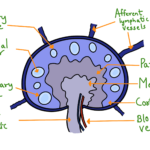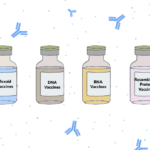Introduction:
Nucleotides are the building blocks of DNA and RNA, essential for all living organisms. They play critical roles in various cellular processes, including energy transfer, signaling, and gene expression. While nucleotides can be obtained from the diet, cells also possess the remarkable ability to synthesize them de novo. In this blog post, we will delve into the intricate mechanisms of de novo purine and pyrimidine biosynthesis, exploring the key enzymes involved and the regulation of these vital pathways.
Section 1: De Novo Purine Biosynthesis
Purines, including adenine and guanine, are synthesized de novo from simple precursors in a multistep process. Let’s explore the steps involved:
1.1. Step 1: Initial Formation of 5-Phosphoribosyl-1-Pyrophosphate (PRPP)
The synthesis of purines begins with the formation of PRPP, a precursor molecule derived from ribose-5-phosphate. The enzyme PRPP synthetase catalyzes the transfer of pyrophosphate from ATP to ribose-5-phosphate, yielding PRPP.
1.2. Step 2: Formation of 5-Phosphoribosylamine (PRA)
In the second step, PRPP reacts with glutamine, releasing pyrophosphate and forming 5-phosphoribosylamine (PRA). This reaction is catalyzed by the enzyme amidophosphoribosyltransferase.
1.3. Step 3: Assembly of the Purine Ring
The synthesis of the purine ring involves a series of enzymatic reactions. PRA undergoes a series of transformations, including rearrangement, ring closure, and carbon-nitrogen bond formation. Several enzymes, such as GAR transformylase, adenylosuccinate synthase, and adenylosuccinate lyase, contribute to the formation of inosine monophosphate (IMP), the first purine nucleotide.
1.4. Step 4: Conversion of IMP to Adenine and Guanine Nucleotides
IMP serves as a precursor for both adenine and guanine nucleotides. IMP is converted to adenylosuccinate, which is then transformed into AMP (adenosine monophosphate) by adenylosuccinate lyase. Similarly, IMP can be converted to GMP (guanosine monophosphate) through the action of IMP dehydrogenase.
Section 2: De Novo Pyrimidine Biosynthesis
Pyrimidines, such as cytosine, thymine, and uracil, are synthesized through a distinct pathway from simpler precursor molecules. Let’s explore the steps involved:
2.1. Step 1: Formation of Carbamoyl Phosphate
The synthesis of pyrimidines begins with the formation of carbamoyl phosphate. In this step, carbamoyl phosphate synthetase II catalyzes the condensation of glutamine, bicarbonate, and ATP, producing carbamoyl phosphate.
2.2. Step 2: Assembly of the Pyrimidine Ring
The pyrimidine ring is constructed on the carbamoyl phosphate scaffold. Aspartate transcarbamylase and dihydroorotase are the key enzymes involved in this process. They catalyze the formation of dihydroorotate, which is further converted into orotate.
2.3. Step 3: Formation of UMP, CMP, and TMP
Orotate is phosphorylated by orotate phosphoribosyltransferase, yielding orotidine 5′-monophosphate (OMP). OMP is then decarboxylated by OMP decarboxylase, forming uridine 5′-monophosphate (UMP). UMP serves as a precursor for both cytidine 5′-monophosphate (CMP) and thymidine 5′-monophosphate (TMP) through a series of enzymatic reactions.
Section 3: Regulation of Nucleotide Biosynthesis
The de novo synthesis of purines and pyrimidines is tightly regulated to maintain proper nucleotide pools in the cell. Here are some key regulatory mechanisms:
3.1. Feedback Inhibition
Several enzymes involved in nucleotide biosynthesis are subject to feedback inhibition by the end products of the pathway. For example, IMP and GMP inhibit PRPP synthetase, ensuring that excessive nucleotide production is prevented.
3.2. Gene Expression Regulation
The expression of genes encoding enzymes involved in nucleotide biosynthesis is regulated at the transcriptional level. Transcription factors and signaling pathways modulate the expression of these genes in response to cellular needs.
3.3. Nucleotide Salvage Pathways
Cells possess salvage pathways that recycle and salvage nucleotides from the degradation of DNA and RNA. This salvage process reduces the demand for de novo synthesis and contributes to maintaining nucleotide homeostasis.
Conclusion:
De novo purine and pyrimidine biosynthesis pathways are essential for the production of nucleotides, the building blocks of DNA and RNA. Understanding the intricate steps and regulatory mechanisms involved in these pathways is crucial for unraveling the mysteries of nucleotide metabolism. Through meticulous research and dedicated study, scientists continue to deepen our knowledge of these processes, shedding light on various diseases and potential therapeutic interventions.
Keywords: de novo purine biosynthesis, de novo pyrimidine biosynthesis, nucleotide metabolism, regulation of nucleotide biosynthesis, purine and pyrimidine synthesis enzymes



